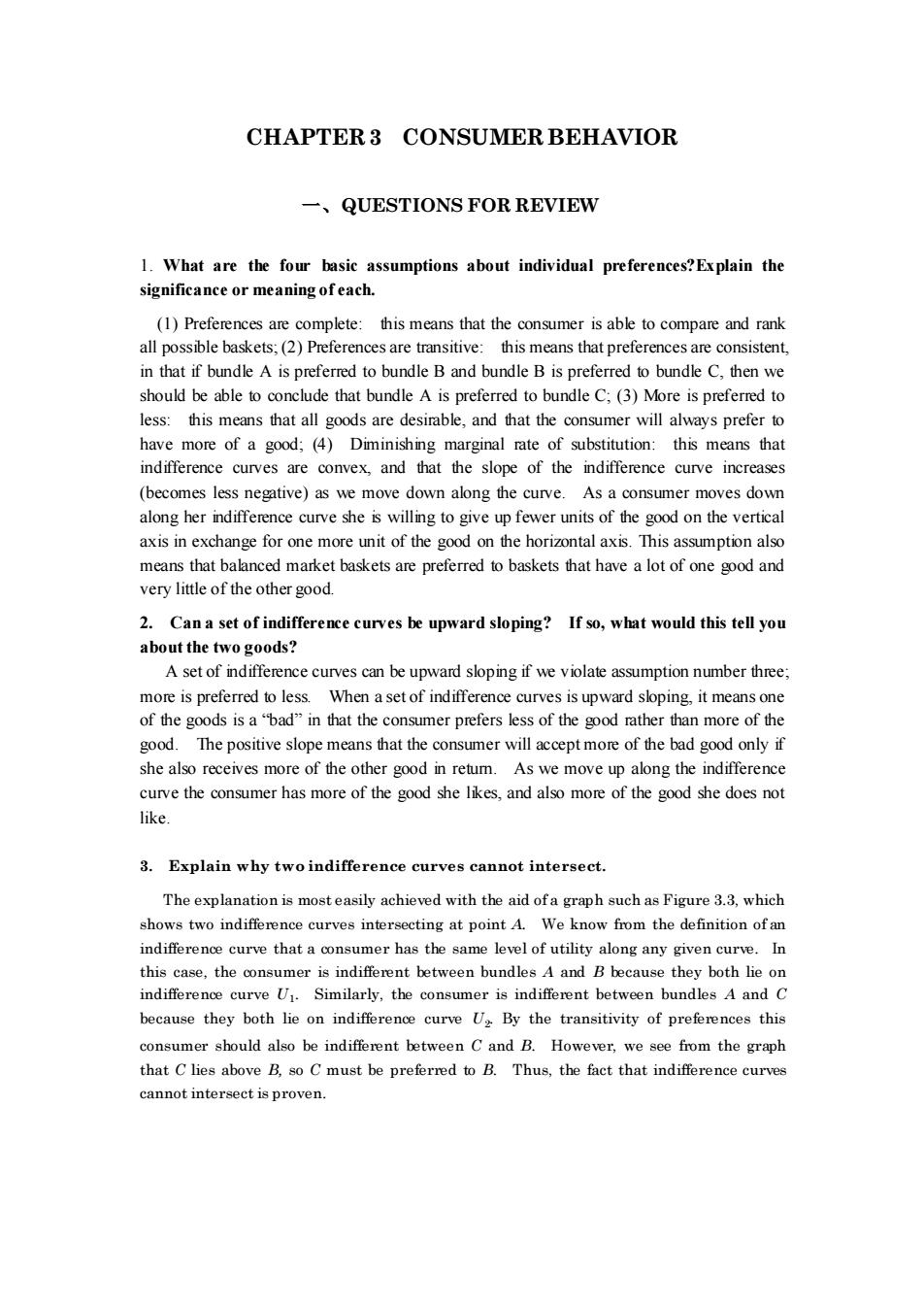
CHAPTER3 CONSUMER BEHAVIOR 一、QUESTIONS FOR REVIEW 1.What are the four basic assumptions about individual preferences?Explain the significance or meaning ofeach. (1)Preferences are complete:this means that the consumer is able to compare and rank all possible baskets:(2)Preferences are transitive:this means that preferencesare consistent. in that is preferred to bu Band bunle Bis prefer red to bundle C.then should be able to conclude that bundle A is preferred to bundleC.(3)More is preferred to less:this means that all goods are desirable,and that the consumer will always prefer to have more of a good;(4)Diminishing marginal rate of substitution:this means that indifference curves are convex,and that the slope of the indifference curve increases (becomes less negative)as we move down along the curve.As a consumer moves down along her indifference curve she s willing to give up fewer units of the good on the vertica axis in exchange for one more unit of the good on the horizontal axis.This assumption also means that balanced market baskets are preferred to baskets that have a lot of one good and very little of the other good. 2.Cana set of indifference curves be upward sloping?If so,what would this tell you about the two goods? A set of indiffe ence curves can be upward slping if we violate assumption number three more is preferred to less.When a set of indifference curves is upward sloping.it means one of the goods is a"bad"in that the consumer prefers lss of the good rather than more of the good.The positive slope means that the consumer will accept more of the bad good only if she also receives more of the other good in retum.As we move up along the indifference curve the consumer has more of the good she likes.and also like. mo元 of the good she does not 3.Explain why twoindifference curves cannot intersect. The explanation is most easily achieved with the aid ofa graph such as Figure 3.3,which shows two indifference curves intersecting at point A.We know from the definition ofan curve thai t a con mer has level of utilit ng any given c this case.theoo t between bundle and 3 because th indifferene curve U.Similarly,the consumer is indifferent between bundles A and because they both lie on indifference curve U2 By the transitivity of preferences this consumer should also be indifferent between C and B.However,we see from the graph that Clies above B.soCmust be preferred to B.Thus,the fact that indifference eurve cannot intersect is proven
CHAPTER 3 CONSUMER BEHAVIOR 一、QUESTIONS FOR REVIEW 1. What are the four basic assumptions about individual preferences?Explain the significance or meaning of each. (1) Preferences are complete: this means that the consumer is able to compare and rank all possible baskets; (2) Preferences are transitive: this means that preferences are consistent, in that if bundle A is preferred to bundle B and bundle B is preferred to bundle C, then we should be able to conclude that bundle A is preferred to bundle C; (3) More is preferred to less: this means that all goods are desirable, and that the consumer will always prefer to have more of a good; (4) Diminishing marginal rate of substitution: this means that indifference curves are convex, and that the slope of the indifference curve increases (becomes less negative) as we move down along the curve. As a consumer moves down along her indifference curve she is willing to give up fewer units of the good on the vertical axis in exchange for one more unit of the good on the horizontal axis. This assumption also means that balanced market baskets are preferred to baskets that have a lot of one good and very little of the other good. 2. Can a set of indifference curves be upward sloping? If so, what would this tell you about the two goods? A set of indifference curves can be upward sloping if we violate assumption number three; more is preferred to less. When a set of indifference curves is upward sloping, it means one of the goods is a “bad” in that the consumer prefers less of the good rather than more of the good. The positive slope means that the consumer will accept more of the bad good only if she also receives more of the other good in return. As we move up along the indifference curve the consumer has more of the good she likes, and also more of the good she does not like. 3. Explain why two indifference curves cannot intersect. The explanation is most easily achieved with the aid of a graph such as Figure 3.3, which shows two indifference curves intersecting at point A. We know from the definition of an indifference curve that a consumer has the same level of utility along any given curve. In this case, the consumer is indifferent between bundles A and B because they both lie on indifference curve U1 . Similarly, the consumer is indifferent between bundles A and C because they both lie on indifference curve U2 . By the transitivity of preferences this consumer should also be indifferent between C and B. However, we see from the graph that C lies above B, so C must be preferred to B. Thus, the fact that indifference curves cannot intersect is proven
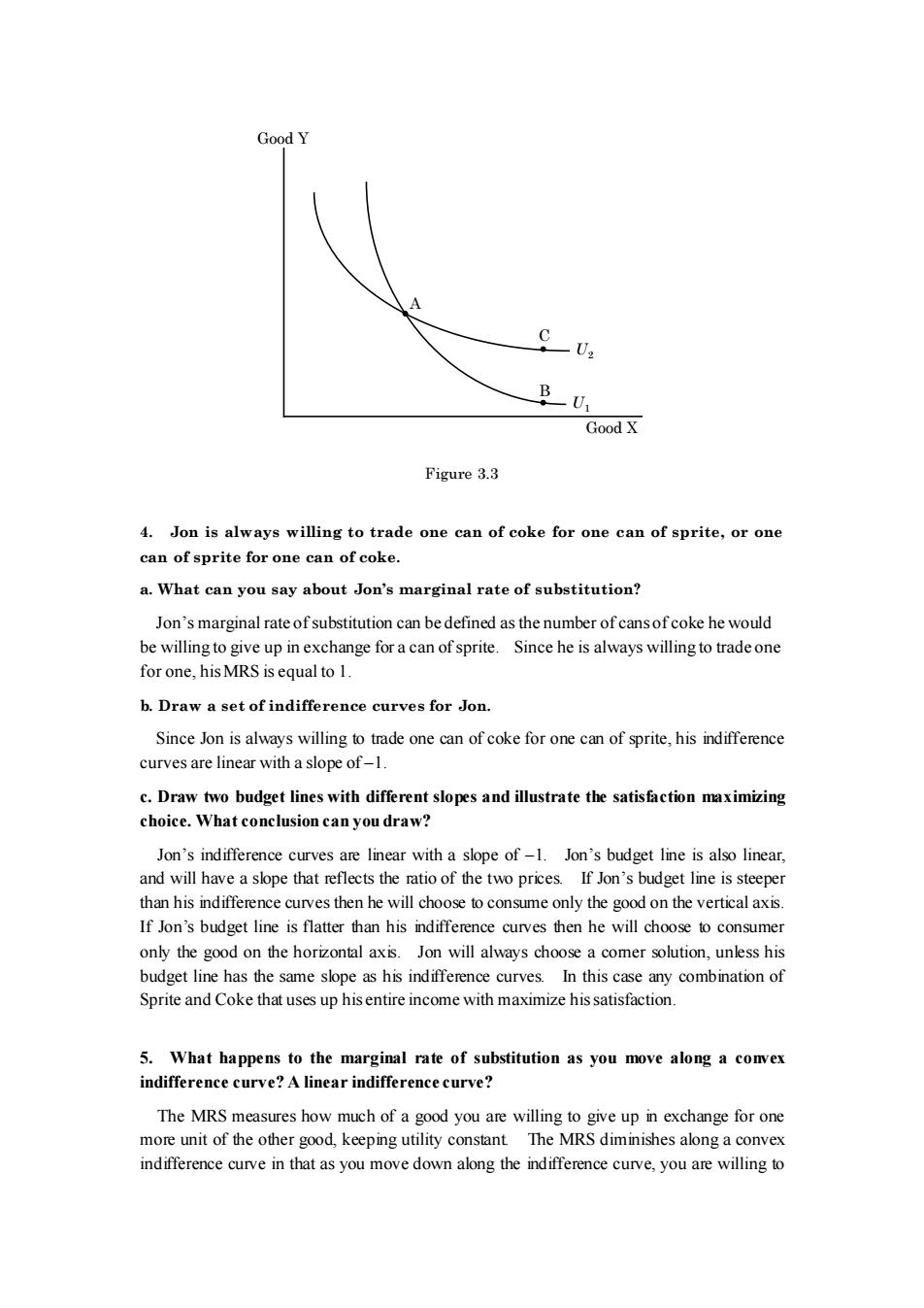
Good Y cU: Cood又 Figure3.3 4.Jon is always willing to trade one can of coke for one can of sprite,or one can of sprite for one can of coke. a.What can you say about Jon's marginal rate of substitution? Jon's marginal rate ofsubstitution can be defined as the number of cansof coke he would be willing to give up in exchange for a can of sprite.Since he is always willing to trade one for one,hisMRS isequal to b.Draw a set of indifference curves for Jon. Since Jon is always willing to trade one can of coke for one of prite,his indifference curves are linear with a slope of1 c.Draw two budget lines with different slopes and illustrate the satisfaction maximizing choice.What conclusion can you draw? Jon's indifference curves are linear with a slope of-1.Jon's budget line is also linear. and will have a slope that reflects the ratio of the two prices If Jon's budget line is steeper than his indifference curves then he will choose to consume only the good on the vertical axis If on's budget line is flatter an he wll sumer only the good on the horiontal axis.Jon will always choose a comer solution,unss his budget line has the same slope as his indifference curves.In this case any combination of Sprite and Coke that uses up hisentire income with maximize his satisfaction. 5.What happens to the marginal rate of substitution as you move along a convex indifference curve?A linear indifference curve? The MRS measures how much of a good you are willing t more unit of the other good,keeping utility constant indifference curve in that as you move down along the indifference curve,you are willing to
Good Y Good X A C B U1 U2 Figure 3.3 4. Jon is always willing to trade one can of coke for one can of sprite, or one can of sprite for one can of coke. a. What can you say about Jon’s marginal rate of substitution? Jon’s marginal rate of substitution can be defined as the number of cans of coke he would be willing to give up in exchange for a can of sprite. Since he is always willing to trade one for one, his MRS is equal to 1. b. Draw a set of indifference curves for Jon. Since Jon is always willing to trade one can of coke for one can of sprite, his indifference curves are linear with a slope of –1. c. Draw two budget lines with different slopes and illustrate the satisfaction maximizing choice. What conclusion can you draw? Jon’s indifference curves are linear with a slope of –1. Jon’s budget line is also linear, and will have a slope that reflects the ratio of the two prices. If Jon’s budget line is steeper than his indifference curves then he will choose to consume only the good on the vertical axis. If Jon’s budget line is flatter than his indifference curves then he will choose to consumer only the good on the horizontal axis. Jon will always choose a corner solution, unless his budget line has the same slope as his indifference curves. In this case any combination of Sprite and Coke that uses up his entire income with maximize his satisfaction. 5. What happens to the marginal rate of substitution as you move along a convex indifference curve? A linear indifference curve? The MRS measures how much of a good you are willing to give up in exchange for one more unit of the other good, keeping utility constant. The MRS diminishes along a convex indifference curve in that as you move down along the indifference curve, you are willing to

give up less and less of the one good in exchange for the other.The MRS is also the slope omes less negative)as you move down along The MRS is constant along a linear indifference curve,since in this case the slope does not change.The consumer is always willing to trade the same number of units of one good in exchange for the other. 6.Explain why an MRS between two goods must equal the ratio of the price of the goods for the consumer to achieve maximum satisfaction maintain the same evel market is willing to make between the same two goods.The tangency of the indifference curve with the budget line represents the point at which the trade-offs are equal and consumer satisfaction is maximized.If the MRS between two goods is not equal to the ratio of prices. ample,if the slope of the budget line o of the he prices)is consumer can trade 4 units of good 2 for one unit of good 1.If the MRS at the current bundle is-6.then the consumer is willing to trade 6 units of good 2 for one unit of good 1.Since the two slopes are not equal the consumer is not maximizing her satisfaction.The consumer is willing to trade 6 butonly has to trade 4 so she should make the trade This trading continues mtil is achieved. As trades are made,the MRS will change 7.Describe the indifference curves associated with two goods that are perfect substitutes. What if they are perfect complements? Two goods are perfect substitutes if the MRS of one for another is a constant number Given the MRS is a constant number,the slope of the indifference curves will be constant, and the indifference curves are therefore linear.If two goods are perfect complements,the curves are Lshaped.In this case the consumer wa nts to sume the two goods in a fixed proportion,say one unit of good I for every I unit of good 2 If she has more of one good but not more of the other then she does not get any extrasatisfaction. 8.What is the difference between ordinal utility and cardinal utility?Explain why the assumption of cardinal utility is not needed in order to rank consumer choices Ordinal utility implies an ordering among alternatives without regard for intensity of preference For exampl,if the consumer's first choice is preferred to their second choie then utility from the first choice will be higher than utility from the second choice.How much higher is not important.An ordinal utility function generates a ranking of bundles and no meaning is given to the utility number itself Cardinal utility implies that the intensity of preferenes may be quantified,and that the utility number itself has meaning An ordinal ranking is all that is needed to rank consumer choices.It is not necessary know how intensely a consumer prefers basket Aover basket B:it is enough to know that A is preferred to B
give up less and less of the one good in exchange for the other. The MRS is also the slope of the indifference curve, which increases (becomes less negative) as you move down along the indifference curve. The MRS is constant along a linear indifference curve, since in this case the slope does not change. The consumer is always willing to trade the same number of units of one good in exchange for the other. 6. Explain why an MRS between two goods must equal the ratio of the price of the goods for the consumer to achieve maximum satisfaction. The MRS describes the rate at which the consumer is willing to trade one good for another to maintain the same level of satisfaction. The ratio of prices describes the trade-off that the market is willing to make between the same two goods. The tangency of the indifference curve with the budget line represents the point at which the trade-offs are equal and consumer satisfaction is maximized. If the MRS between two goods is not equal to the ratio of prices, then the consumer could trade one good for another at market prices to obtain higher levels of satisfaction. For example, if the slope of the budget line (the ratio of the prices) is –4 then the consumer can trade 4 units of good 2 for one unit of good 1. If the MRS at the current bundle is –6, then the consumer is willing to trade 6 units of good 2 for one unit of good 1. Since the two slopes are not equal the consumer is not maximizing her satisfaction. The consumer is willing to trade 6 but only has to trade 4, so she should make the trade. This trading continues until the highest level of satisfaction is achieved. As trades are made, the MRS will change and become equal to the price ratio. 7. Describe the indifference curves associated with two goods that are perfect substitutes. What if they are perfect complements? Two goods are perfect substitutes if the MRS of one for another is a constant number. Given the MRS is a constant number, the slope of the indifference curves will be constant, and the indifference curves are therefore linear. If two goods are perfect complements, the indifference curves are L-shaped. In this case the consumer wants to consume the two goods in a fixed proportion, say one unit of good 1 for every 1 unit of good 2. If she has more of one good but not more of the other then she does not get any extra satisfaction. 8. What is the difference between ordinal utility and cardinal utility? Explain why the assumption of cardinal utility is not needed in order to rank consumer choices. Ordinal utility implies an ordering among alternatives without regard for intensity of preference. For example, if the consumer’s first choice is preferred to their second choice, then utility from the first choice will be higher than utility from the second choice. How much higher is not important. An ordinal utility function generates a ranking of bundles and no meaning is given to the utility number itself. Cardinal utility implies that the intensity of preferences may be quantified, and that the utility number itself has meaning. An ordinal ranking is all that is needed to rank consumer choices. It is not necessary to know how intensely a consumer prefers basket A over basket B; it is enough to know that A is preferred to B
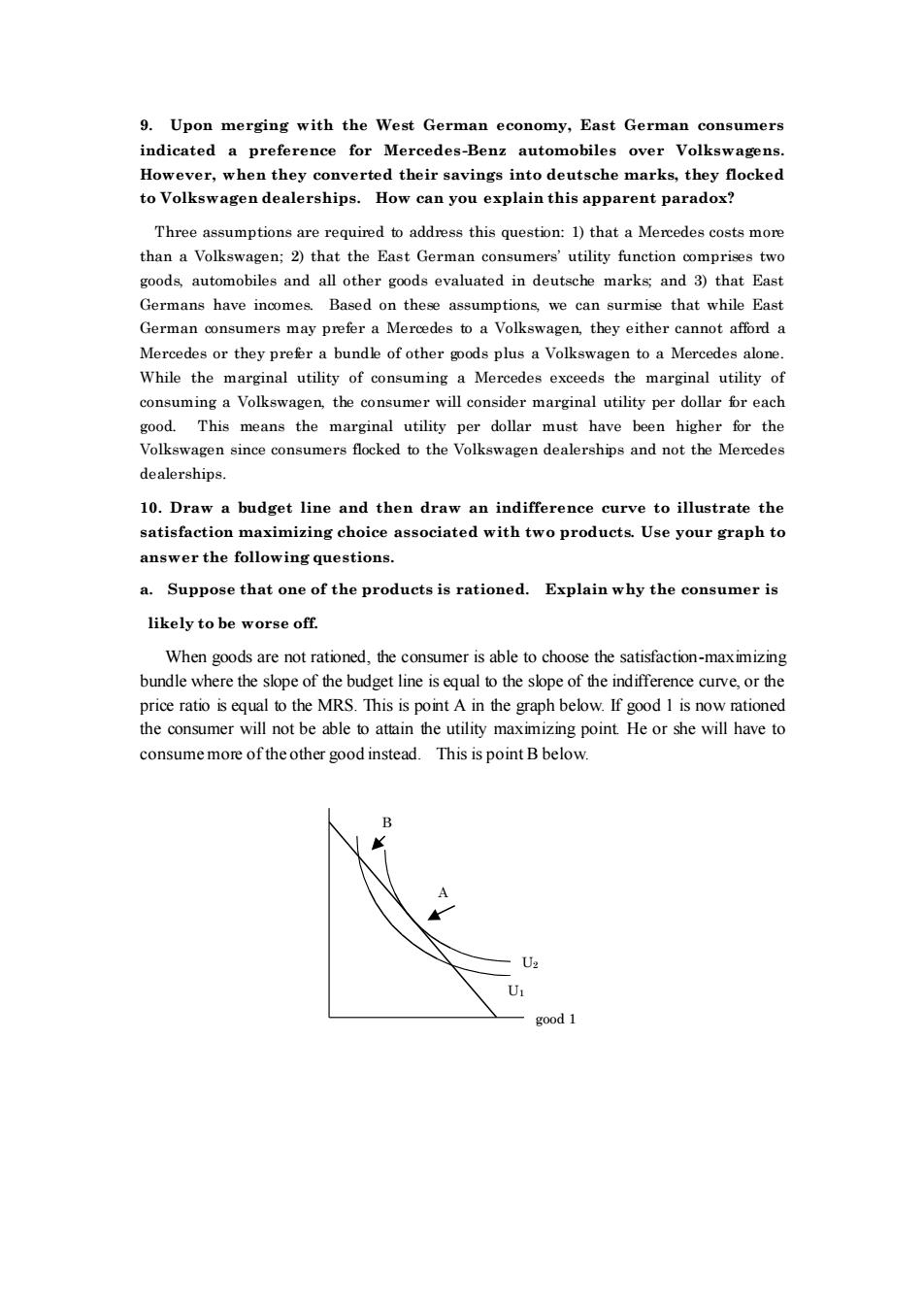
9.Upon merging with the West German economy,East German consumers indicated a preference for Mercedes-Benz automobiles over Volkswagens However when they converted their savings into deutsche marks they flocked to Volkswagen dealerships.How can you explain this apparent paradox? Three assumptions are required to address this question:1)that a Mercedes costs more than a Volkswagen;2)that the East German consumers'utility function comprises two goods,automobiles and all other goods evaluated in deutsche marks and 3)that East Germans have incomes.Based on these assumptions,we can surr mise that while east they eithe anno Mercedes or they prefer a bundle of other goods plus a Volkswagen to a Mercedes alone While the marginal utility of consuming a Mercedes exceeds the marginal utility of consuming a Volkswagen,the consumer will consider marginal utility per dollar for each his means theni pet ollar muat have bon higher fr the sinc on wagen dealership dealerships. 10.Draw a budget line and then draw an indifference curve to illustrate the satisfaction maximizing choice associated with two products.Use your graph to answer the following questions. a.Suppose that one of the products is rationed.Explain why the consumer is likely to be worse off. When goods are not rationed,the consumer is able to choose the satisfaction-maximizing bundle where the slope of the budget line is cqual to the slope of the indifference curveor the ual to the MRS.This no ratione not be able to attain the utility maximizing point He or she will have to consume more of the other good instead.This is point B below
9. Upon merging with the West German economy, East German consumers indicated a preference for Mercedes-Benz automobiles over Volkswagens. However, when they converted their savings into deutsche marks, they flocked to Volkswagen dealerships. How can you explain this apparent paradox? Three assumptions are required to address this question: 1) that a Mercedes costs more than a Volkswagen; 2) that the East German consumers’ utility function comprises two goods, automobiles and all other goods evaluated in deutsche marks; and 3) that East Germans have incomes. Based on these assumptions, we can surmise that while East German consumers may prefer a Mercedes to a Volkswagen, they either cannot afford a Mercedes or they prefer a bundle of other goods plus a Volkswagen to a Mercedes alone. While the marginal utility of consuming a Mercedes exceeds the marginal utility of consuming a Volkswagen, the consumer will consider marginal utility per dollar for each good. This means the marginal utility per dollar must have been higher for the Volkswagen since consumers flocked to the Volkswagen dealerships and not the Mercedes dealerships. 10. Draw a budget line and then draw an indifference curve to illustrate the satisfaction maximizing choice associated with two products. Use your graph to answer the following questions. a. Suppose that one of the products is rationed. Explain why the consumer is likely to be worse off. When goods are not rationed, the consumer is able to choose the satisfaction-maximizing bundle where the slope of the budget line is equal to the slope of the indifference curve, or the price ratio is equal to the MRS. This is point A in the graph below. If good 1 is now rationed the consumer will not be able to attain the utility maximizing point. He or she will have to consume more of the other good instead. This is point B below. good 1 U1 U2 A B
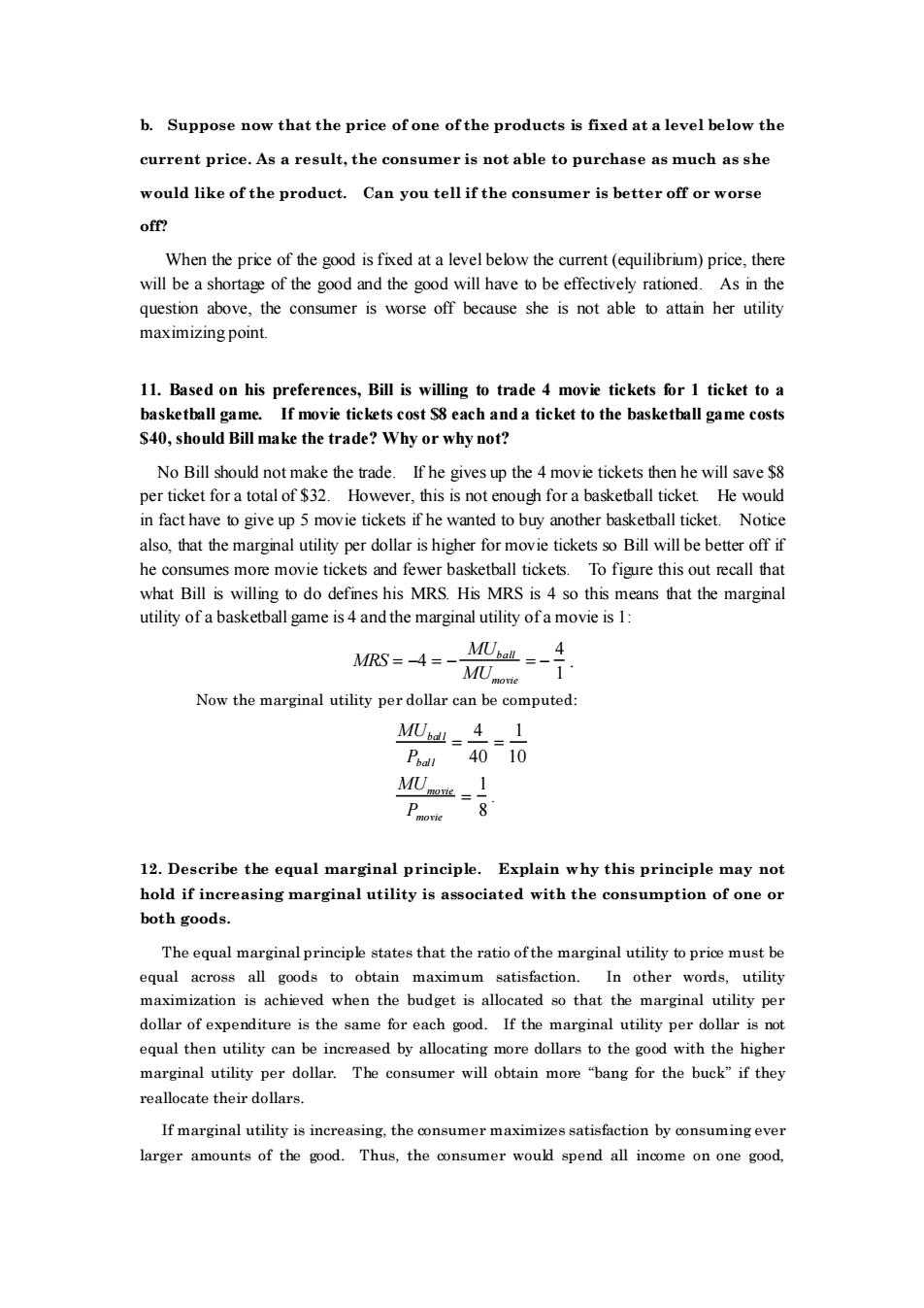
b.Suppose now that the price ofone ofthe products is fixed at a level below the current price.As a result,the consumer is not able to purchase as much as she would like of the product.Can you tell if the consumer is better off or wors When the price of the good isfixed at a level belw the curent ()price.there will be a shortage of the good and the good will have to be effectively rationed As in th question above,the consumer is worse off because she is not able to attain her utility maximizing point. 11.Based on his preferences,Bill is willing to trade 4 movie tickets for 1 ticket to a baskethall game. If movie tickets cost 58 each and a ticket to the basketball game costs S40,should Bill make the trade?Why or why not? No Bill should not make the trade.If he gives up the 4 movie tickets then he will save $8 per ticket for a total of $32.However,this is not enoug for a basketball ticket He woul in fact have to give up 5 movie tickets if he wanted to buy another basketball ticket.Notice also,that the marginal utility per dollar is higher for movie tickets so Bill will be better off if he consumes more movie tickets and fewer basketball tickets.To figure this out recall that what Bill is willin utility of a ba all game is 4 and the marginal utility of a movie is 1 MRS=4-MU Now the marginal utility per dollar can be computed: 40=10 Po 12.Describe the equal marginal principle.Explain why this principle may not hold if in reasing marginal utility is associated with the consumption of one or both goods. The equal marginal principle states that the ratio of the marginal utility to price must be equal across all goods to obtain maximum satisfaction.In other words,utility maximization is achieved when the budget is allocated so that the marginal utility per dolar of expenditure is the same for each good.If the marginal utility per dollar is equal then utility can be g m e dollars to the goo vith the highe marginal utility per dollar.The consumer will obtain more "bang for the buck"if they reallocate their dollars. If marginal utility is increasing.the consumer maximizes satisfaction by consuming ever larger amounts of the good.Thus,the consumer would spend all income on one good
b. Suppose now that the price of one of the products is fixed at a level below the current price. As a result, the consumer is not able to purchase as much as she would like of the product. Can you tell if the consumer is better off or worse off? When the price of the good is fixed at a level below the current (equilibrium) price, there will be a shortage of the good and the good will have to be effectively rationed. As in the question above, the consumer is worse off because she is not able to attain her utility maximizing point. 11. Based on his preferences, Bill is willing to trade 4 movie tickets for 1 ticket to a basketball game. If movie tickets cost $8 each and a ticket to the basketball game costs $40, should Bill make the trade? Why or why not? No Bill should not make the trade. If he gives up the 4 movie tickets then he will save $8 per ticket for a total of $32. However, this is not enough for a basketball ticket. He would in fact have to give up 5 movie tickets if he wanted to buy another basketball ticket. Notice also, that the marginal utility per dollar is higher for movie tickets so Bill will be better off if he consumes more movie tickets and fewer basketball tickets. To figure this out recall that what Bill is willing to do defines his MRS. His MRS is 4 so this means that the marginal utility of a basketball game is 4 and the marginal utility of a movie is 1: MRS = −4 = − MUball MUmovie = − 4 1 . Now the marginal utility per dollar can be computed: MUbal l Pbal l = 4 40 = 1 10 MUmovie Pmovie = 1 8 . 12. Describe the equal marginal principle. Explain why this principle may not hold if increasing marginal utility is associated with the consumption of one or both goods. The equal marginal principle states that the ratio of the marginal utility to price must be equal across all goods to obtain maximum satisfaction. In other words, utility maximization is achieved when the budget is allocated so that the marginal utility per dollar of expenditure is the same for each good. If the marginal utility per dollar is not equal then utility can be increased by allocating more dollars to the good with the higher marginal utility per dollar. The consumer will obtain more “bang for the buck” if they reallocate their dollars. If marginal utility is increasing, the consumer maximizes satisfaction by consuming ever larger amounts of the good. Thus, the consumer would spend all income on one good
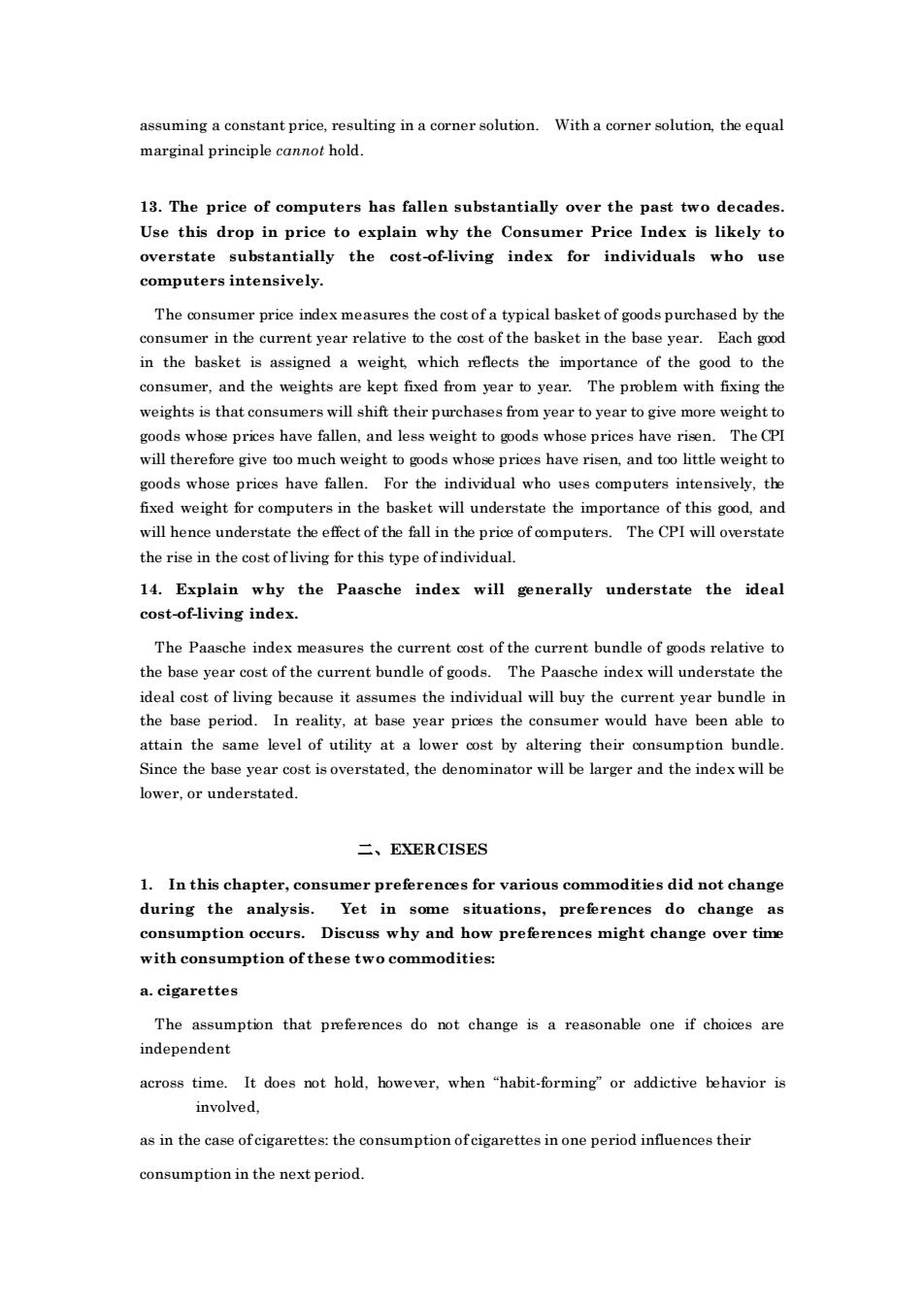
assuming a constant price,resulting in a corner solution.With a corner solution,the equal marginal principle cannot hold. 13.The price of computers has fallen substantially over the past two decades Use this drop in price to explain why the Consumer Price Index is likely to overstate substantially the cost-of-living index for individuals who use computers intensively. The consumer price index measures the cost of a typical basket of goods purchased by the omer in ofthe basket in the base year.Each good which reflects the importance the good to the consumer,and the weights are kept fixed from year to year.The problem with fixing the weights is that consumers will shift their purchases from year to year to give more weight to goods whose prices have fallen.and less weight to goods whose prices have risen.The CPl will therefore give too much weight to goods whose prices have risen,and too little weight to et will understate the importance of this good.and will hence understate the effect of the fall in the price of computers.The CPI will overstate the rise in the cost of living for this type of individual. 14.Explain why the Paasche index will generally understate the ideal cost-of living index. The Paasche index measures the current cost of the current bundle of goods relative to the base year cost of the current bundle of goods.The Pa sche i index will understate the ideal cost of living because it assumes the individual will buy the current year bundle in the base period.In reality.at base year prices the consumer would have been able to attain the same level of utility at a lower cost by altering their consumption bundle. Since the base year cost is overstated,the denominator will be larger and the index will be lower,or understated. 二、EXERCISES 1.In this chapter,consumer preferences for various commodities did not change during the analysis. Yet in some situations,preferences do change as consumption occurs.Discuss why and how preferences might change over time with consumption ofthese two commodities: a.cigarettes The assumption that preferences do not change is a reasonable one if choices are independent across time.It does not hold,however,when"habit-forming"or addictive behavior is involved, as in the case ofcigarettes:the consumption ofcigarettes in one period influences their consumption in the next period
assuming a constant price, resulting in a corner solution. With a corner solution, the equal marginal principle cannot hold. 13. The price of computers has fallen substantially over the past two decades. Use this drop in price to explain why the Consumer Price Index is likely to overstate substantially the cost-of-living index for individuals who use computers intensively. The consumer price index measures the cost of a typical basket of goods purchased by the consumer in the current year relative to the cost of the basket in the base year. Each good in the basket is assigned a weight, which reflects the importance of the good to the consumer, and the weights are kept fixed from year to year. The problem with fixing the weights is that consumers will shift their purchases from year to year to give more weight to goods whose prices have fallen, and less weight to goods whose prices have risen. The CPI will therefore give too much weight to goods whose prices have risen, and too little weight to goods whose prices have fallen. For the individual who uses computers intensively, the fixed weight for computers in the basket will understate the importance of this good, and will hence understate the effect of the fall in the price of computers. The CPI will overstate the rise in the cost of living for this type of individual. 14. Explain why the Paasche index will generally understate the ideal cost-of-living index. The Paasche index measures the current cost of the current bundle of goods relative to the base year cost of the current bundle of goods. The Paasche index will understate the ideal cost of living because it assumes the individual will buy the current year bundle in the base period. In reality, at base year prices the consumer would have been able to attain the same level of utility at a lower cost by altering their consumption bundle. Since the base year cost is overstated, the denominator will be larger and the index will be lower, or understated. 二、EXERCISES 1. In this chapter, consumer preferences for various commodities did not change during the analysis. Yet in some situations, preferences do change as consumption occurs. Discuss why and how preferences might change over time with consumption of these two commodities: a. cigarettes The assumption that preferences do not change is a reasonable one if choices are independent across time. It does not hold, however, when “habit-forming” or addictive behavior is involved, as in the case of cigarettes: the consumption of cigarettes in one period influences their consumption in the next period
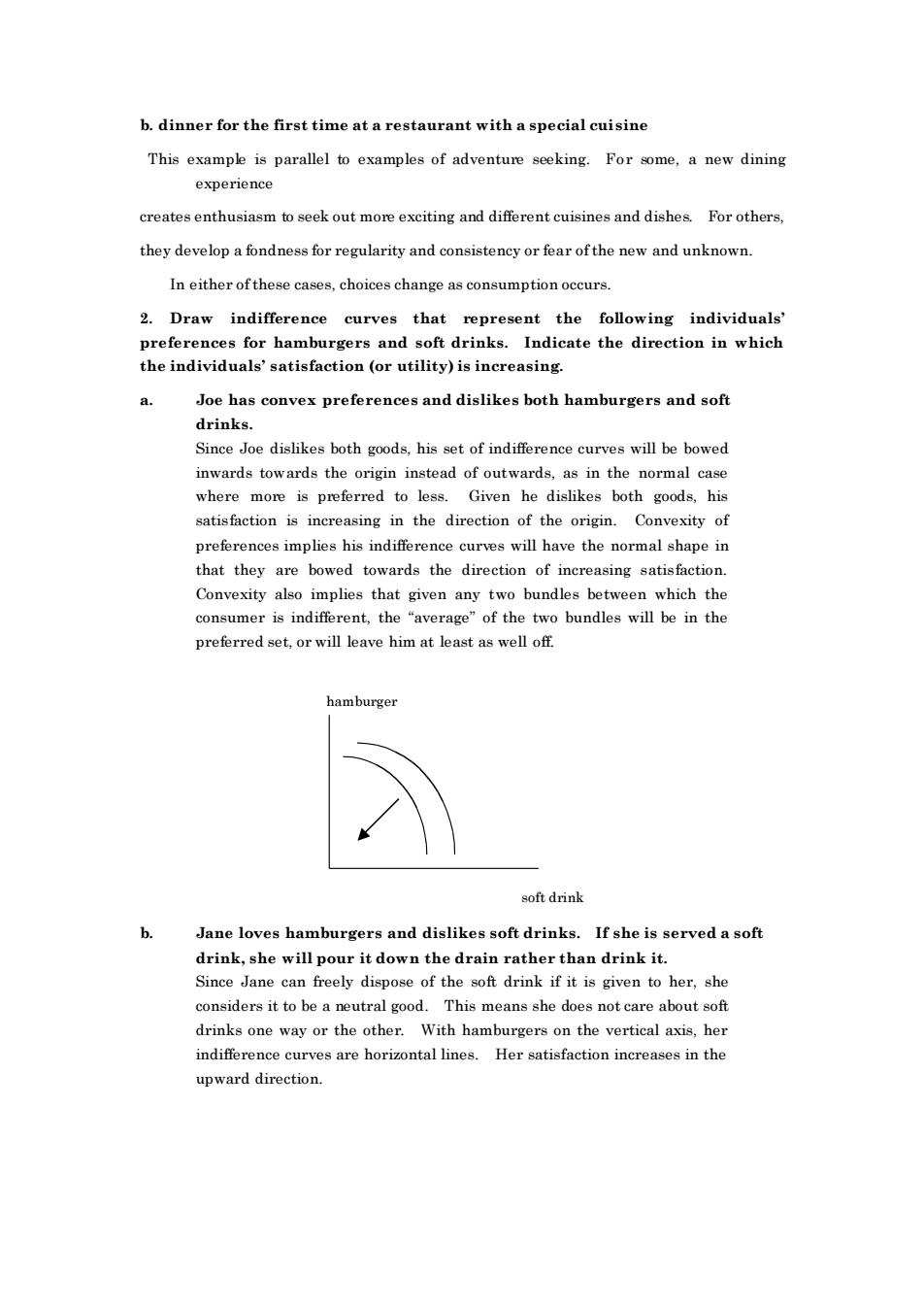
b.dinner for the first time at a restaurant with a special cuisine This example is parallel to examples of adventure seeking.For some,a new dining experience creates enthusiasm to seek out more exciting and different cuisines and dishes For others they develop a fondness for regularity and consistency or fear of the new and unknown. In either of these cases,choices change as consumption occurs. 2.Draw indifference curves that represent the following individuals preferences for hamburgers and soft drinks.Indicate the direction in which the individuals'satisfaction (or utility)is increasing. a. Joe has convex preferences and dislikes both hamburgers and soft drinks Since Joe dislikes both goods,his set of indifference curves will be bowed inwards towards the origin insteado outwards,as in the normal cas where more is preferred to less.Given he dislikes both goods,hi satisfaction is increasing in the direction of the origin.Convexity of preferences implies his indifference curves will have the normal shape in that they are bowed towards the direction of increasing satisfaction. Convexityals implies tha t given any two bundles between which the consumer is indifferent,the "average"of the two bundles will be in the preferred set,or will leave him at least as well off. hamburger soft drink Jane loves hamburgers and dislikes soft drinks.If she is served a soft drink,she will pour it down the drain rather than drink it. Since Jane of the soft drink if it is given to her,she considersit to bea neutral good This means she does not care about sof drinks one way or the other.With hamburgers on the vertical axis,her indifference curves are horizontal lines.Her satisfaction increases in the upward direction
b. dinner for the first time at a restaurant with a special cuisine This example is parallel to examples of adventure seeking. For some, a new dining experience creates enthusiasm to seek out more exciting and different cuisines and dishes. For others, they develop a fondness for regularity and consistency or fear of the new and unknown. In either of these cases, choices change as consumption occurs. 2. Draw indifference curves that represent the following individuals’ preferences for hamburgers and soft drinks. Indicate the direction in which the individuals’ satisfaction (or utility) is increasing. a. Joe has convex preferences and dislikes both hamburgers and soft drinks. Since Joe dislikes both goods, his set of indifference curves will be bowed inwards towards the origin instead of outwards, as in the normal case where more is preferred to less. Given he dislikes both goods, his satisfaction is increasing in the direction of the origin. Convexity of preferences implies his indifference curves will have the normal shape in that they are bowed towards the direction of increasing satisfaction. Convexity also implies that given any two bundles between which the consumer is indifferent, the “average” of the two bundles will be in the preferred set, or will leave him at least as well off. hamburger soft drink b. Jane loves hamburgers and dislikes soft drinks. If she is served a soft drink, she will pour it down the drain rather than drink it. Since Jane can freely dispose of the soft drink if it is given to her, she considers it to be a neutral good. This means she does not care about soft drinks one way or the other. With hamburgers on the vertical axis, her indifference curves are horizontal lines. Her satisfaction increases in the upward direction
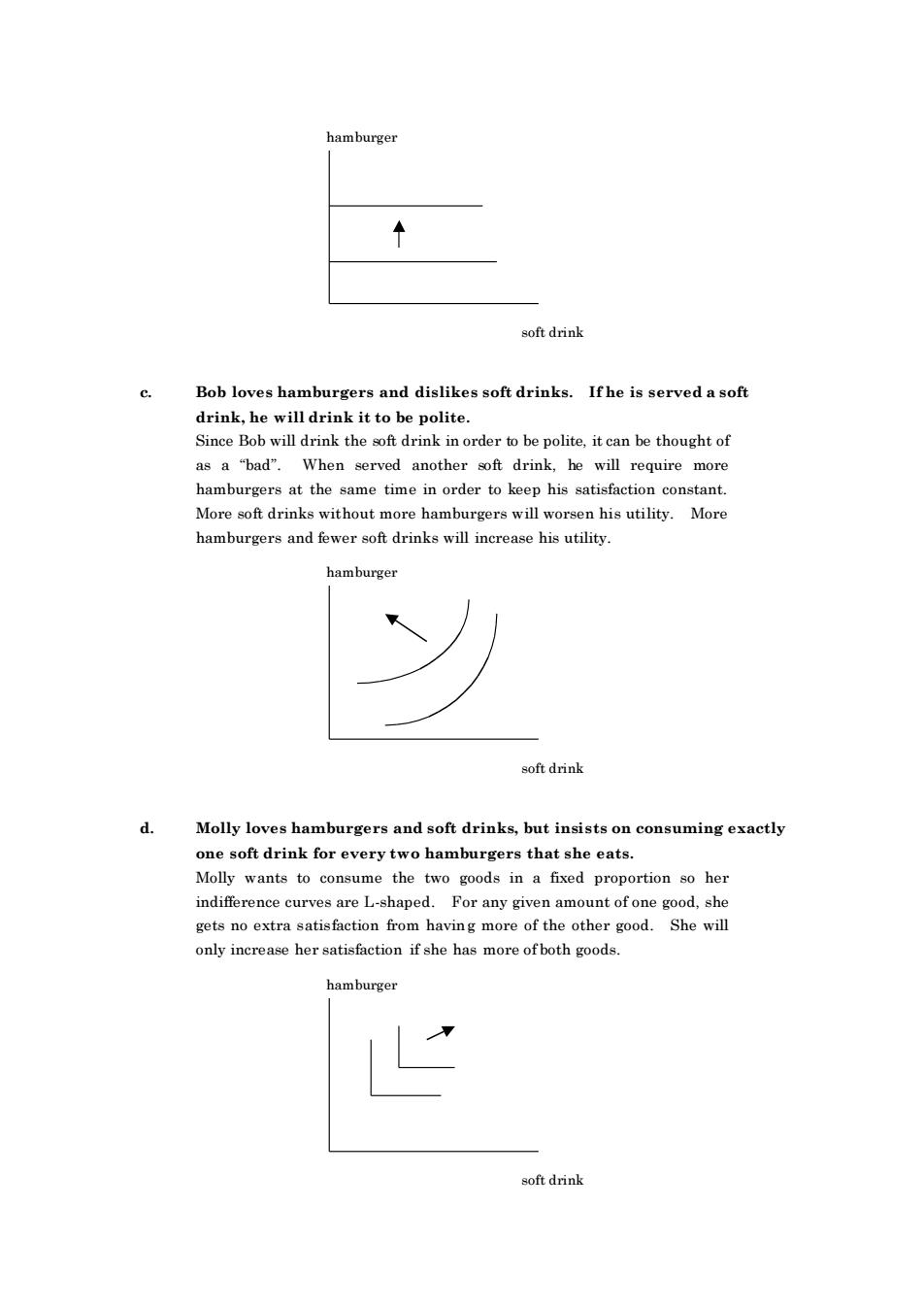
↑ soft drink Bob loves hamburgers and dislikes soft drinks.If he is served a soft Since Bol as a "bad".When served another soft drink,he will require more hamburgers at the same time in order to keep his satisfaction constant. More soft drinks without more hamburgers will worsen his utility.More hamburgers and fewer soft drinks will increase his utility. eoftdrink Molly loves hamburgers and soft drinks,but insists on consuming exactly one soft drink for every two hamburgers that she eats. Molly wants to consume the two goods in a fixed proportion so her indifference curves are l-shaped.For any given amount of one good.she gets no extra satisfaction from having more of the other good.She will e her satisfaction if she ha more of both goods
hamburger soft drink c. Bob loves hamburgers and dislikes soft drinks. If he is served a soft drink, he will drink it to be polite. Since Bob will drink the soft drink in order to be polite, it can be thought of as a “bad”. When served another soft drink, he will require more hamburgers at the same time in order to keep his satisfaction constant. More soft drinks without more hamburgers will worsen his utility. More hamburgers and fewer soft drinks will increase his utility. hamburger soft drink d. Molly loves hamburgers and soft drinks, but insists on consuming exactly one soft drink for every two hamburgers that she eats. Molly wants to consume the two goods in a fixed proportion so her indifference curves are L-shaped. For any given amount of one good, she gets no extra satisfaction from having more of the other good. She will only increase her satisfaction if she has more of both goods. hamburger soft drink
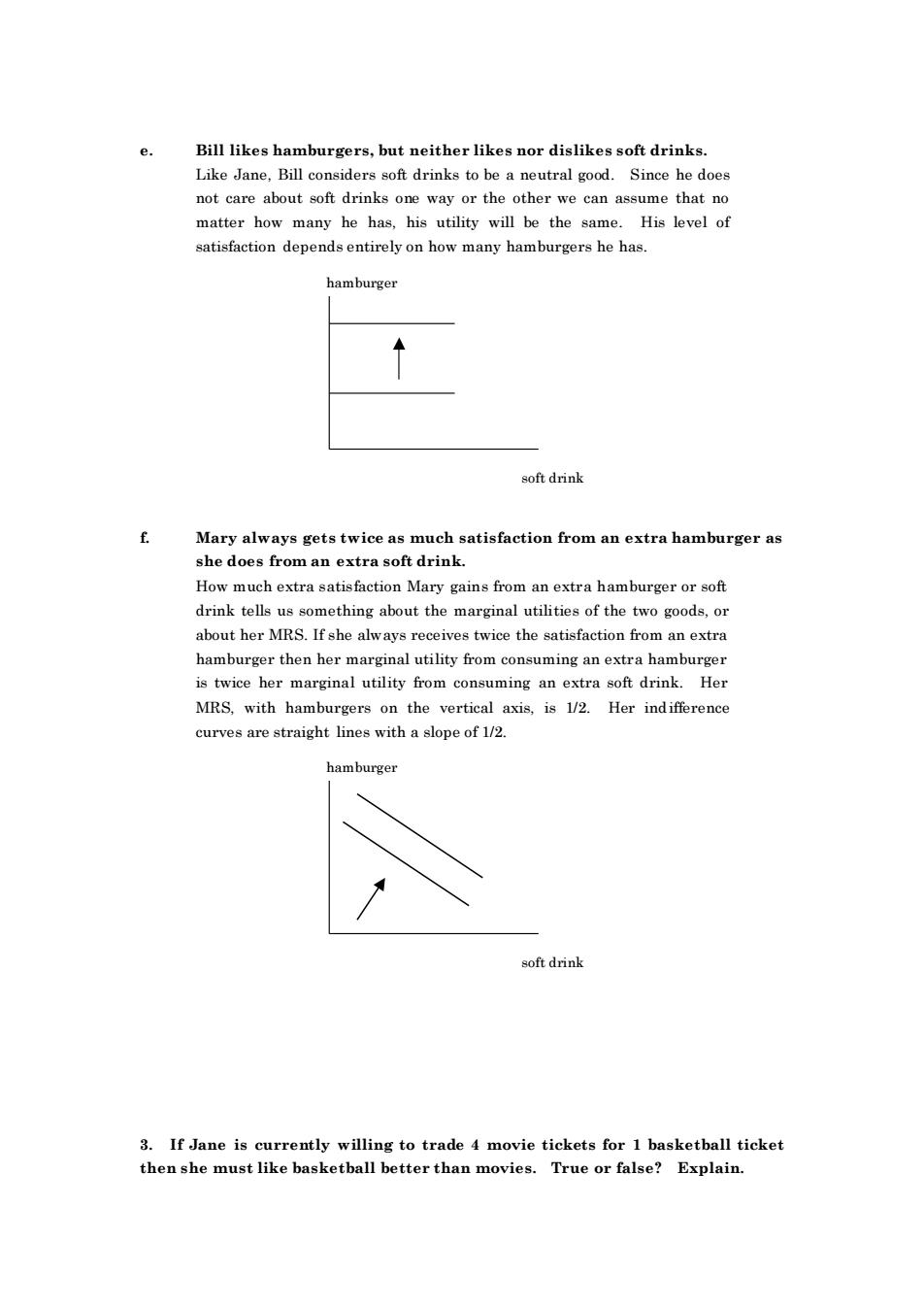
Bill likes hamburgers,but neither likes nor dislikes soft drinks Like Jane,Bill drinks to be a neutral good.Since he does not care about soft drinks one way or the other we can assume that no matter how many he has,his utility will be the same.His level of satisfaction depends entirely on how many hamburgers he has. Mary always gets twice as much satisfaction from an extra hamburger as she does from an extra soft drink How much extra satisfaction Mary gains from an extra hamburger or soft drink tells us something about the marginal utilities of the two goods,or about her MRS.If she always receives twice the satisfaction from an extra hamburger then her marginal utility from consuming an extra hamburge is twice her marginal utility from consuming an extra so drink.He MRS,with hamburgers on the vertical axis,is 1/2.Her indifference curves are straight lines with a slope of 1/2. 3.If Jane is currently willing to trade 4 movie tickets for 1 basketball ticket then she must like basketball better than movies.True or false?Explain
e. Bill likes hamburgers, but neither likes nor dislikes soft drinks. Like Jane, Bill considers soft drinks to be a neutral good. Since he does not care about soft drinks one way or the other we can assume that no matter how many he has, his utility will be the same. His level of satisfaction depends entirely on how many hamburgers he has. hamburger soft drink f. Mary always gets twice as much satisfaction from an extra hamburger as she does from an extra soft drink. How much extra satisfaction Mary gains from an extra hamburger or soft drink tells us something about the marginal utilities of the two goods, or about her MRS. If she always receives twice the satisfaction from an extra hamburger then her marginal utility from consuming an extra hamburger is twice her marginal utility from consuming an extra soft drink. Her MRS, with hamburgers on the vertical axis, is 1/2. Her indifference curves are straight lines with a slope of 1/2. hamburger soft drink 3. If Jane is currently willing to trade 4 movie tickets for 1 basketball ticket then she must like basketball better than movies. True or false? Explain

This statement is not necessarily true.If she is always willing to trade 4 because she will always gain the same satisfiction frommovie ticke ets a she does from 1 basketball ticket.However,it could be that she has convex preferences (diminishing marginal rate of substitution)and is at a bundle where she has a lot of movie tickets relative to basketball tickets. This would make her willing to give up more movie tickets to get another basketball ticket. It would not mean thoug she liked basketball better.Her willingness to give up a good would in this case depend on the quantity ofeach good in her current basket. 4.Janelle and Brian each plan to spend $20.000 on the stvling and gas mileage features of a new car.They can each choose all styling.all gas mileage,or some combination of the two.Janelle does not care at all about styling and wants the best gas mileage possible.Brian likes both qually and nta nd an amount on the e two features. Using indifference curves and budget lines illustrate the choice that each person will make. Assume styling is on the vertical axis and gas mileage is on the horizontal axis.Janelle has indifference curves that are vertical.If the styling is there she will take it.but she otherwise does not care about it.As her indifference curves move over to the right,she gains more gas mileage and more satisfaction.She will spend all $20.000 on gas mileage.Brian ha indifference curves that are L-shaped.He will not spend more on one feature than on the other feature.He will spend $10,000 on styling and $10.000 on gas mileage. Suppose that Bridget and Erin spend their incom on two goods,food(间 and clothing (C). Bridget's preferences are represented by the utility function U(FC)=10FC,while Erin's preferences are represented by the utility function UF,C)=.20F2C2 On a graph,with food on the horizontal axis and clothing on the vertical axis,identify the set of points that give Bridget the same level ofutility as the bundle(10,5).Do the same for Erin on a separate graph Bridget receives a utility of 10*10*5=500 from this bundle indifference curve is represented by the equation 10FC=500 or FC-50 Some bundles on this indifference curve are (5,10),(10,5)(25,2),and (2,25). Erin receives a utility of.2*10*10*5*5=500 from the bundle (10,5).Her 50=FC This is the curve as Bridget. indifference curves have the normal,convex shape On the same two graphs,identify the set of bundles that give Bridget and Erin the same level of utility as the bundle (15.8)
This statement is not necessarily true. If she is always willing to trade 4 movie tickets for 1 basketball ticket then yes she likes basketball better because she will always gain the same satisfaction from 4 movie tickets as she does from 1 basketball ticket. However, it could be that she has convex preferences (diminishing marginal rate of substitution) and is at a bundle where she has a lot of movie tickets relative to basketball tickets. This would make her willing to give up more movie tickets to get another basketball ticket. It would not mean though that she liked basketball better. Her willingness to give up a good would in this case depend on the quantity of each good in her current basket. 4. Janelle and Brian each plan to spend $20,000 on the styling and gas mileage features of a new car. They can each choose all styling, all gas mileage, or some combination of the two. Janelle does not care at all about styling and wants the best gas mileage possible. Brian likes both equally and wants to spend an equal amount on the two features. Using indifference curves and budget lines, illustrate the choice that each person will make. Assume styling is on the vertical axis and gas mileage is on the horizontal axis. Janelle has indifference curves that are vertical. If the styling is there she will take it, but she otherwise does not care about it. As her indifference curves move over to the right, she gains more gas mileage and more satisfaction. She will spend all $20,000 on gas mileage. Brian has indifference curves that are L-shaped. He will not spend more on one feature than on the other feature. He will spend $10,000 on styling and $10,000 on gas mileage. 5. Suppose that Bridget and Erin spend their income on two goods, food (F) and clothing (C). Bridget’s preferences are represented by the utility function U(F,C) = 10FC , while Erin’s preferences are represented by the utility function U(F,C) = .20F 2C 2 . a. On a graph, with food on the horizontal axis and clothing on the vertical axis, identify the set of points that give Bridget the same level of utility as the bundle (10,5). Do the same for Erin on a separate graph. Bridget receives a utility of 10*10*5=500 from this bundle. The indifference curve is represented by the equation 10FC=500 or FC=50. Some bundles on this indifference curve are (5,10), (10,5), (25,2), and (2,25). Erin receives a utility of .2*10*10*5*5=500 from the bundle (10,5). Her indifference curve is represented by the equation 500 = .2F 2C 2 , or 50=FC. This is the same indifference curve as Bridget. Both indifference curves have the normal, convex shape. b. On the same two graphs, identify the set of bundles that give Bridget and Erin the same level of utility as the bundle (15,8)